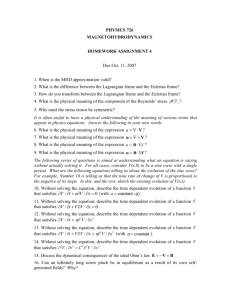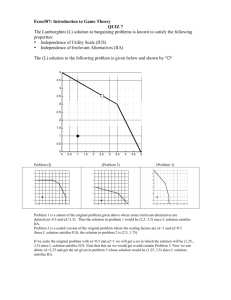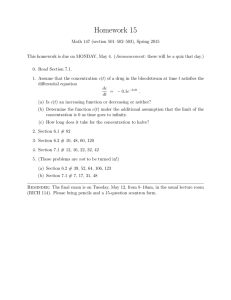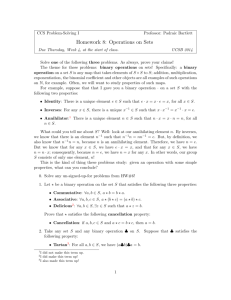ON BROWDER-TYPE THEOREMS
advertisement
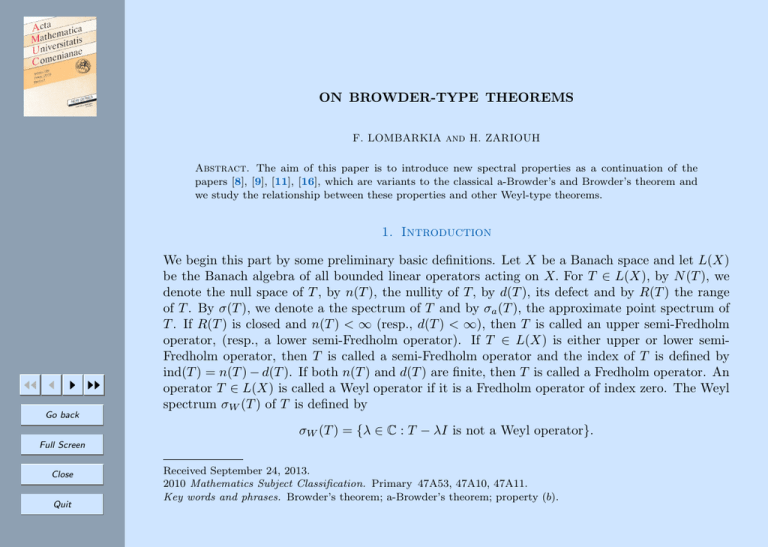
ON BROWDER-TYPE THEOREMS
F. LOMBARKIA and H. ZARIOUH
Abstract. The aim of this paper is to introduce new spectral properties as a continuation of the
papers [8], [9], [11], [16], which are variants to the classical a-Browder’s and Browder’s theorem and
we study the relationship between these properties and other Weyl-type theorems.
1. Introduction
JJ J
I II
Go back
We begin this part by some preliminary basic definitions. Let X be a Banach space and let L(X)
be the Banach algebra of all bounded linear operators acting on X. For T ∈ L(X), by N (T ), we
denote the null space of T , by n(T ), the nullity of T, by d(T ), its defect and by R(T ) the range
of T . By σ(T ), we denote a the spectrum of T and by σa (T ), the approximate point spectrum of
T . If R(T ) is closed and n(T ) < ∞ (resp., d(T ) < ∞), then T is called an upper semi-Fredholm
operator, (resp., a lower semi-Fredholm operator). If T ∈ L(X) is either upper or lower semiFredholm operator, then T is called a semi-Fredholm operator and the index of T is defined by
ind(T ) = n(T ) − d(T ). If both n(T ) and d(T ) are finite, then T is called a Fredholm operator. An
operator T ∈ L(X) is called a Weyl operator if it is a Fredholm operator of index zero. The Weyl
spectrum σW (T ) of T is defined by
σW (T ) = {λ ∈ C : T − λI is not a Weyl operator}.
Full Screen
Close
Quit
Received September 24, 2013.
2010 Mathematics Subject Classification. Primary 47A53, 47A10, 47A11.
Key words and phrases. Browder’s theorem; a-Browder’s theorem; property (b).
For a bounded linear operator T and a nonnegative integer n, define T[n] to be the restriction
of T to R(T n ), viewed as a map from R(T n ) into R(T n ) (in particular, T[0] = T ). If for some
integer n, the range space R(T n ) is closed and T[n] , is an upper (resp. a lower) semi-Fredholm
operator, then T is called an upper (resp., a lower) semi-B-Fredholm operator, and in this case,
the index of T is defined as the index of the semi-Fredholm operator T[n] , see [7]. Moreover, if T[n]
is a Fredholm operator, then T is called a B-Fredholm operator, see [4]. An operator T ∈ L(X) is
said to be a B-Weyl operator if it is a B-Fredholm operator of index zero. The B-Weyl spectrum
σBW (T ) of T is defined by
σBW (T ) = {λ ∈ C : T − λI is not a B-Weyl operator}.
The ascent a(T ) of an operator T is defined by
a(T ) = inf{n ∈ N : N (T n ) = N (T n+1 )}
and the descent δ(T ) of T is defined by
δ(T ) = inf{n ∈ N : R(T n ) = R(T n+1 )}
Close
with inf ∅ = ∞.
According to [14], a complex number λ ∈ σ(T ) is a pole of the resolvent of T if T − λI has
a finite ascent and finite descent, and in this case, they are equal. According to [6], a complex
number λ ∈ σa (T ) is a left pole of T if a(T − λI) < ∞ and R(T a(T −λI)+1 ) is closed. An operator
T is called Drazin invertible if 0 is a pole of T and is called left Drazin invertible if 0 is a left pole
of T .
Let SF+ (X) be the class of all upper semi-Fredholm operators and
Quit
SF+− (X) = {T ∈ SF+ (X) : ind(T ) ≤ 0}.
JJ J
I II
Go back
Full Screen
The upper-semi Weyl spectrum σSF − (T ) of T is defined by
+
σSF − (T ) = {λ ∈ C : T − λI ∈
/ SF+− (X)}.
+
JJ J
I II
Go back
Full Screen
Close
Quit
Similarly the upper semi-B-Weyl spectrum σSBF − (T ) of T is defined.
+
This paper is a continuation of our recent investigations in the subject of Browder-type theorems.
As in [8] and [9], we investigate other new variants of Browder’s and a-Browder’s theorem by
introducing new spectral properties (see later for Definitions) for bounded linear operators, in
connection with Weyl-type theorems. The essential results obtained in this paper are summarized
in the diagram presented at the end of this paper. For further definitions and symbols, we refer
the reader to [9] and also to [4], [5], [7], [8], [15] and [16] for more details.
Hereafter the symbol isoA means isolated points of a given subset A of C. In addition, we recall
the list of all symbols and notations we use:
E(T ):
eigenvalues of T that are isolated in the spectrum σ(T ),
E 0 (T ):
eigenvalues of T of finite multiplicity that are isolated in σ(T ),
Ea (T ):
eigenvalues of T that are isolated in the approximate point spectrum
σa (T ),
Ea0 (T ):
eigenvalues of T of finite multiplicity that are isolated in σa (T ),
Π(T ):
poles of T,
Π0 (T ):
poles of T of finite rank,
Πa (T ):
left poles of T,
Π0a (T ):
left poles of T of finite rank,
σBW (T ): B-Weyl spectrum of T,
σW (T ):
Weyl spectrum of T,
σSBF − (T ): upper semi-B-Weyl spectrum of T,
+
σSF − (T ): upper-semi Weyl spectrum of T,
+
∆a (T ) = σa (T ) r σSF − (T ),
+
∆ga (T ) = σa (T ) r σSBF − (T ),
+
∆g (T ) = σ(T ) r σBW (T );
∆g+ (T ) = σ(T ) r σSBF − (T ),
+
∆(T ) = σ(T ) r σW (T );
∆+ (T ) = σ(T ) r σSF − (T ),
+
∆(T ) = Π0 (T ): Browder’s theorem holds for T (B for brevity),
∆g (T ) = Π(T ): generalized Browder’s theorem holds for T (gB for brevity),
∆ga (T ) = Π0a (T ): a-Browder’s theorem holds for T (aB for brevity),
∆ga (T ) = Πa (T ): generalized a-Browder’s theorem holds for T (gaB for brevity),
The inclusion of the following table [8], [11], [16], [17] which contains the meaning of some
properties is motivated by having overview of the subject.
(z)
σ(T ) r σSF − (T ) = Ea0 (T )
(gz)
+
Π0a (T )
+
(az)
σ(T ) r σSF − (T ) =
(b)
σa (T ) r σSF − (T ) = Π0 (T )
(gb)
σa (T ) r σSBF − (T ) = Π(T )
(w1 ) σa (T ) r σSF − (T ) ⊂ E 0 (T )
(Bb)
σ(T ) r σBW (T ) = Π0 (T )
+
(gaz) σ(T ) r σSBF − (T ) = Πa (T )
+
+
+
+
JJ J
σ(T ) r σSBF − (T ) = Ea (T )
I II
2. Main results
Go back
Full Screen
Close
Quit
Very recently [11], the property (w1 ) for bounded linear operators as a variant of Weyl’s theorem
was introduced, and the necessary and sufficient conditions for which this property holds were
established. But the next proposition shows that property (w1 ) is equivalent to the property (b)
introduced in [8] and studied by several authors, see, for example, [2], [8].
Proposition 2.1. Let T ∈ L(X). Then the following statements are equivalent.
(i) T satisfies property (w1 );
(ii) T satisfies property (b);
(iii) σa (T ) = σSF − (T ) ∪ iso σ(T ).
+
Proof. (i) ⇐⇒ (ii) Suppose that T satisfies property (w1 ), then
σa (T ) r σSF − (T ) ⊂ E 0 (T ).
+
Thus from [1, Theorem 3.77], we have
λ ∈ σa (T ) r σSF − (T ) ⇐⇒ λ ∈ iso σ(T ) ∩ σSF − (T )C ⇐⇒ λ ∈ Π0 (T ),
+
C
where σSF − (T )
+
+
is the complement of the upper semi-Weyl spectrum of T . So ∆a (T ) = Π0 (T )
and T satisfies property (b). The converse is obvious since Π0 (T ) ⊂ E 0 (T ) is always true.
(ii) =⇒ (iii) Property (b) for T entails that σa (T ) r σSF − (T ) ⊂ iso σ(T ). So σa (T ) ⊂ σSF − (T ) ∪
+
+
iso σ(T ) and since σa (T ) ⊃ σSF − (T ) ∪ iso σ(T ) is always true, then σa (T ) = σSF − (T ) ∪ iso σ(T ).
+
+
The reverse implication is obtained by using the same argument as in the proof of “(i) =⇒ (ii)”. JJ J
I II
Go back
Full Screen
Close
Quit
In the following definition, we investigate new variants of a-Browder-type theorem and Browder’s
theorem.
Definition 2.2. Let T ∈ L(X). We will say that:
• T satisfies property (gw1 ) if ∆ga (T ) ⊂ E(T ).
• T satisfies property (w2 ) if ∆(T ) ⊂ E 0 (T ).
• T satisfies property (gw2 ) if ∆g (T ) ⊂ E(T ).
As a generalization of Proposition 2.1 to the general context of B-Fredholm theory, in the next
result, we prove that property (gb) ⇐⇒ property (gw1 ).
Proposition 2.3. Let T ∈ L(X). Then the following statements are equivalent:
(i) T satisfies property (gw1 );
(ii) T satisfies property (gb);
(iii) σa (T ) = σSBF − (T ) ∪ iso σ(T ).
+
Proof. (i) ⇐⇒ (ii) Assume that T satisfies property (gw1 ), then
σa (T ) r σSBF − (T ) ⊂ E(T ).
+
From the punctured neighborhood theorem [7, Corollary 3.2] we deduce that
λ ∈ σa (T ) r σSBF − (T ) ⇐⇒ λ ∈ iso σ(T ) ∩ σBW (T )C ⇐⇒ λ ∈ Π(T ),
+
C
where σBW (T ) is the complement of the B-Weyl spectrum of T . This implies that ∆ga (T ) = Π(T )
and T satisfies property (gb). The converse is trivial, since Π(T ) ⊂ E(T ) holds for every operator.
(ii) ⇐⇒ (iii) Property (gb) for T entails that σa (T ) r σSBF − (T ) ⊂ iso σ(T ). So σa (T ) ⊂
+
σSBF − (T )∪iso σ(T ) and since σa (T ) ⊃ σSBF − (T )∪iso σ(T ) holds for every operator, then σa (T ) =
+
+
σSBF − (T ) ∪ iso σ(T ). The reverse implication goes similarly to the proof of “(i) =⇒ (ii)”.
+
JJ J
I II
Go back
Full Screen
Close
Quit
Now, the next proposition proves that (w2 ) ⇐⇒ (gw2 ) ⇐⇒ gB ⇐⇒ B.
Proposition 2.4. Let T ∈ L(X). Then the following assertions are equivalent:
(i)
(ii)
(iii)
(iv)
T
T
T
T
satisfies
satisfies
satisfies
satisfies
property (w2 );
Browder’s theorem;
generalized Browder’s theorem;
property (gw2 ).
Proof. (i) ⇐⇒ (ii) Suppose that T satisfies property (w2 ), then σ(T ) r σW (T ) ⊂ E 0 (T ). Thus
λ ∈ σ(T ) r σW (T ) ⇐⇒ λ ∈ iso σ(T ) ∩ σW (T )C ⇐⇒ λ ∈ Π0 (T ),
where σW (T )C is the complement of the Weyl spectrum of T . So ∆(T ) = Π0 (T ) ⇐⇒ ∆(T ) ⊂
E 0 (T ) as desired.
(iii) ⇐⇒ (iv) As ∆(T ) ⊂ ∆g (T ), then (gw2 ) =⇒ (w2 ) =⇒ B. Since B ⇐⇒ gB [i.e. (ii) ⇐⇒
(iii)], see [3, Theorem 2.1] we conclude that (gw2 ) ⇐⇒ gB ⇐⇒ (w2 ).
We investigate new variants of a-Browder’s theorem and other new variants of Browder’s theorem, in the two following definitions (Definitions 2.5 and 2.7).
Definition 2.5. Let T ∈ L(X). We say that:
• T satisfies property (aw1 ) if ∆a (T ) ⊂ Ea0 (T ).
• T satisfies property (gaw1 ) if ∆ga (T ) ⊂ Ea (T ).
• T satisfies property (ab1 ) if ∆(T ) ⊂ Π0a (T ).
• T satisfies property (gab1 ) if ∆g (T ) ⊂ Πa (T ).
• T satisfies property (aw2 ) if ∆(T ) ⊂ Ea0 (T ).
• T satisfies property (gaw2 ) if ∆g (T ) ⊂ Ea (T ).
JJ J
I II
Go back
Full Screen
Close
Quit
The next result proves that (aw1 ) ⇐⇒ (gaw1 ) ⇐⇒ (gaB)
(ab1 ) ⇐⇒ (w2 ) ⇐⇒ (gw2 ) ⇐⇒ (aw2 ) ⇐⇒ (gaw2 ) ⇐⇒ (gab1 ) ⇐⇒ gB ⇐⇒ B.
Proposition 2.6. Let T ∈ L(X). Then
1. The assertions (i)–(iv) are equivalent:
(i) T satisfies property (aw1 );
(ii) T satisfies a-Browder’s theorem;
(iii) T satisfies property (gaw1 );
(iv) T satisfies generalized a-Browder’s theorem.
⇐⇒
aB
and
2. The
(a)
(b)
(c)
(d)
(e)
assertions (a)–(e) are equivalent:
T satisfies property (ab1 );
T satisfies property (w2 );
T satisfies property (gab1 );
T satisfies property (aw2 );
T satisfies property (gaw2 ).
Proof. 1. (i) ⇐⇒ (ii) Suppose that T satisfies property (aw1 ). Then σa (T )rσSF − (T ) ⊂ Ea0 (T ).
+
Thus
λ ∈ σa (T ) r σSF − (T ) ⇐⇒ λ ∈ iso σa (T ) ∩ σSF − (T )C ⇐⇒ λ ∈ Π0a (T ).
+
+
This implies that
∆a (T ) = Π0a (T ) ⇐⇒ ∆a (T ) ⊂ Ea0 (T ).
JJ J
I II
Go back
Full Screen
as desired.
(iii) ⇐⇒ (iv) As ∆a (T ) ⊂ ∆ga (T ), then (gaw1 ) =⇒ (aw1 ) =⇒ aB. Since aB ⇐⇒ gaB
[i.e., (ii)⇐⇒ (iv)], see [3, Theorem 2.2], we conclude that (gaw1 ) ⇐⇒ gaB.
2. (a) ⇐⇒ (b) Suppose that T satisfies property (ab1 ). Then σ(T ) r σW (T ) ⊂ Π0a (T ). Thus
λ ∈ ∆(T ) implies a(T − λI) < ∞ and since ind(T − λI) = 0, then a(T − λI) = δ(T − λI) < ∞.
Hence λ ∈ ∆(T ) ⇐⇒ λ ∈ Π0 (T ). So ∆(T ) ⊂ E 0 (T ). Conversely, if property (w2 ) holds for T ,
then from Proposition 2.4, we have ∆(T ) = Π0 (T ) ⊂ Π0a (T ), i.e., property (ab1 ) holds for T .
(b)=⇒ (d), (c) =⇒ (a), (e) =⇒ (d) and (c) =⇒ (e) are clear.
(e) =⇒ (c) Suppose that T satisfies property (gaw2 ). Then σ(T ) r σBW (T ) ⊂ Ea (T ). Thus
λ ∈ σ(T ) r σBW (T ) =⇒ λ ∈ iso σa (T ) ∩ σSBF − (T )C ⇐⇒ λ ∈ Πa (T ),
+
Close
Quit
C
where σSBF − (T ) is the complement of the upper semi-B-Weyl spectrum of T . Then ∆g (T ) ⊂
+
Πa (T ) as desired. Similarly, we prove the implication (d) =⇒ (a).
(b) =⇒ (c) Property (w2 ) for T implies from Proposition 2.4 that ∆g (T ) = Π(T ). Hence
∆ (T ) ⊂ Πa (T ). This completes the proof.
g
Definition 2.7. Let T ∈ L(X). We will say that:
• T satisfies property (Bw1 ) if ∆g (T ) ⊂ E 0 (T ).
• T satisfies property (Bab1 ) if ∆g (T ) ⊂ Π0a (T ).
• T satisfies property (Baw1 ) if ∆g (T ) ⊂ Ea0 (T ).
Similarly to Proposition 2.6, in the next result, we show that (Bw1 ) ⇐⇒ (Bab1 ) ⇐⇒ (Baw1 ) ⇐⇒
(Bb), and under the assumption Π(T ) = Π0 (T ), (Bw1 ) ⇐⇒ gB.
Proposition 2.8. Let T ∈ L(X). Then
1. The following assertions are equivalent:
(i) T satisfies property (Bw1 );
(ii) T satisfies property (Bab1 );
(iii) T satisfies property (Baw1 );
(iv) T satisfies property (Bb).
2. T satisfies property (Bw1 ) ⇐⇒ T satisfies property (gab1 ) and Π(T ) = Π0 (T ).
JJ J
I II
Proof. 1. (ii) ⇐⇒ (iii) Since Π0a (T ) ⊂ Ea0 (T ) holds for every operator, this proves the direct
implication. Conversely, suppose that ∆g (T ) ⊂ Ea0 (T ). Then
Go back
λ ∈ σ(T ) r σBW (T ) =⇒ λ ∈ iso σa (T ) ∩ σSF − (T )C ⇐⇒ λ ∈ Π0a (T ).
Full Screen
Thus ∆g (T ) ⊂ Π0a (T ).
(i)=⇒ (iii) Obvious since E 0 (T ) ⊂ Ea0 (T ) is always true.
(ii)=⇒ (i) Suppose that ∆g (T ) ⊂ Π0a (T ). Then ∆g (T ) ⊂ Πa (T ). From Proposition 2.6, we have
g
∆ (T ) ⊂ E(T ). Thus ∆g (T ) ⊂ E 0 (T ).
+
Close
Quit
(i) ⇐⇒ (iv) Suppose that ∆g (T ) ⊂ E 0 (T ). Then
λ ∈ σ(T ) r σBW (T ) =⇒ λ ∈ iso σ(T ) ∩ σW (T )C ⇐⇒ λ ∈ Π0 (T ).
Hence ∆g (T ) = Π0 (T ) as desired. The reverse implication is clear.
2. If T satisfies property (Bw1 ), then it satisfies property (Bb) that is σ(T ) r σBW (T ) =
Π0 (T ) ⊂ Π(T ). Hence σ(T ) r σBW (T ) = Π(T ) and this is equivalent from Proposition 2.6 to the
property (gab1 ). So T satisfies (gab1 ) and Π(T ) = Π0 (T ). The converse is trivial.
From Proposition 2.8 we remark that if T ∈ L(X) satisfies property (Bw1 ) then it satisfies
property (gab1 ). But the converse does not hold in general: for example, let U ∈ L(`2 (N)) be
defined by U (x1 , x2 , x3 , . . . ) = (0, x2 , x3 , . . . ) for all (x) = (xi ) ∈ `2 (N). Then σ(U ) = σa (U ) =
{0, 1}, σBW (U ) = ∅ and Πa (U ) = {0, 1}. So ∆g (U ) ⊂ Πa (U ), i.e., U satisfies property (gab1 ), but
it does not satisfy property (Bw1 ) because E 0 (U ) = {0}. Here Π(U ) = {0, 1} and Π0 (U ) = {0}.
In the following corollary, we combine the results obtained in Propositions 2.4, 2.6 and 2.8.
JJ J
I II
Go back
Full Screen
Close
Quit
Corollary 2.9. Let T ∈ L(X). Then we have:
1. T satisfies B ⇐⇒ T satisfies gB ⇐⇒ T satisfies (ab1 ) ⇐⇒ T satisfies (w2 ) ⇐⇒ T satisfies
(gw2 ) ⇐⇒ T satisfies (gab1 ) ⇐⇒ T satisfies (aw2 ) ⇐⇒ T satisfies (gaw2 ).
2. T satisfies (Bw1 ) ⇐⇒ T satisfies (Bab1 ) ⇐⇒ T satisfies (Baw1 ) ⇐⇒ T satisfies (Bb).
3. T satisfies aB ⇐⇒ T satisfies gaB ⇐⇒ T satisfies (aw1 ) ⇐⇒ T satisfies (gaw1 ).
Recall that an operator T ∈ L(X) is said to satisfy property (SBb) if ∆ga (T ) = Π0 (T ) which
introduced very recently in [10]. In the next definition, we investigate new variants of property
(az) [16] and new variants of property (SBb) [10].
Definition 2.10. Let T ∈ L(X). We will say that:
• T satisfies property (z1 ) if ∆+ (T ) ⊂ Ea0 (T ).
• T satisfies property (gz1 ) if ∆g+ (T ) ⊂ Ea (T ).
• T satisfies property (SBw1 ) if ∆ga (T ) ⊂ E 0 (T ).
• T satisfies property (SBaw1 ) if ∆ga (T ) ⊂ Ea0 (T ).
The next result shows that (z1 ) ⇐⇒ (gz1 ) ⇐⇒ (az) ⇐⇒ (gaz) and (SBw1 ) ⇐⇒ (SBb) =⇒
(SBaw1 ).
Proposition 2.11. Let T ∈ L(X). Then
1. The
(i)
(ii)
(iii)
2. The
(a)
(b)
3. If T
properties (i)–(iii) are equivalent:
T satisfies property (z1 );
T satisfies property (gz1 );
T satisfies property (az).
properties (a)–(b) are equivalent:
T satisfies property (SBw1 );
T satisfies property (SBb);
satisfies property (SBb) then it satisfies property (SBaw1 ).
Proof. 1. The equivalence (i) ⇐⇒ (iii) is clear.
(ii) =⇒ (iii) Suppose that ∆g+ (T ) ⊂ Ea (T ). Then
JJ J
I II
λ ∈ σ(T ) r σSF − (T ) =⇒ λ ∈ σ(T ) r σSBF − (T )
+
+
⇐⇒ λ ∈ iso σa (T ) ∩ σSF − (T )C ⇐⇒ λ ∈ Π0a (T ).
Go back
+
Full Screen
Close
Quit
Π0a (T )
Hence ∆+ (T ) =
as desired. The equivalence of (az) and (gaz) follows from [16, Corollary
3.5]. Hence this proves the reverse implication (iii) =⇒ (ii).
2. Since it was already mentioned we have E 0 (T ) ⊂ Ea0 (T ) and Π0 (T ) ⊂ E 0 (T ). Then immediately we obtain the equivalence of two properties (a) and (b). The third assertion is obvious. As a conclusion, we give a summary of the results obtained in this paper. In the following diagram, arrows signify implications between the properties studied in this paper and other
Browder-type theorems. The numbers near the arrows are references to the results in the present
paper (numbers without brackets) or to the bibliography therein (numbers in square brackets).
JJ J
I II
Go back
Full Screen
Close
Quit
(gz1 )
m 2.11
(z1 )
(w2 )
m 2.11
m 2.6
(gaz)
(w1 )
m 2.1
[8]
(b)
−−−−→
x
[8]
(gb)
JJ J
I II
m 2.3
(gw1 )
Go back
Full Screen
Close
Quit
[8]
−−−−→
(aw2 )
m [16]
m 2.6
(az)
[16]
y
(ab1 )
aB
m 2.9
[12]
−−−−→
m [3]
gaB
(Bab1 )
m 2.8
B
m [3]
[6]
−−−−→
gB
[17]
←−−−−
(Bw1 )
(SBw1 )
m 2.8
m 2.11
(Bb)
m 2.6
m 2.9
m 2.8
(gaw1 )
(gab1 )
(Baw1 )
m 2.6
m 2.6
(aw1 )
(gaw2 )
m 2.9
(gw2 )
[10]
←−−−−
(SBb)
m 2.11
(SBaw1 )
JJ J
I II
Go back
Full Screen
Close
Quit
1. Aiena P., Fredholm and Local Spectral Theory, with Application to Multipliers, Kluwer Academic Publishers,
2004.
2. Aiena P., Weyl type theorems for polaroid operators, Extracta Math. 23(2) (2008), 103–118.
3. Amouch M. and Zguitti H., On the equivalence of Browder’s and generalized Browder’s theorem, Glasgow
Math. J. 48 (2006), 179–185.
4. Berkani M., On a class of quasi-Fredholm operators, Integr. Equ. and Oper. Theory 34(2) (1999), 244–249.
, Index of B-Fredholm operators and generalization af A Weyl theorem, Proc. Amer. Math. Soc 130
5.
(2002), 1717–1723.
6. Berkani M. and Koliha J. J., Weyl type theorems for bounded linear operators, Acta Sci. Math. (Szeged) 69
(2003), 359–376.
7. Berkani M. and Sarih M., On semi B-Fredholm operators, Glasgow Math. J. 43 (2001), 457–465.
8. Berkani M. and Zariouh H., Extended Weyl type theorems, Math. Bohemica 134(4) (2009), 369–378.
9.
, New extended Weyl type theorems, Math. Vesnik. 62(2) (2010), 145–154.
10. Berkani M., Kachad M., Zariouh H. and Zguitti H., Variations on a-Browder-type theorems, Srajevo J. Math.
Vol. 9 (22) (2013), 271–281.
11. Chenhui Sun, Xiaohong Cao and Lei Dai, Property (w1 ) and Weyl type theorem, J. Math. Anal. Appl. 363
(2010), 1–6.
12. Djordjević S. V. and Han Y. M., Browder’s theorems and spectral continuity, Glasgow Math. J. 42 (2000),
479–486.
13. Il Ju An and Young Min Han, New Extended Weyl Type Theorems and Polaroid Operators, Filomat 27(6)
(2013), 1061–1073.
14. Heuser H., Functional Analysis, John Wiley & Sons Inc, New York 1982.
15. Lombarkia F. and Zariouh H., Operators possessing properties (gb) and (gw), Bull. Math. Anal. Appl. 4 (2012),
17–28.
16. Zariouh H., Property (gz) for bounded linear operators, Math. Vesnik. 65 (2013), 94–103.
17. Zariouh H. and Zguitti H., Variations on Browder’s Theorem, Acta Math. Univ. Comenianae 81(2) (2012),
255–264.
F. Lombarkia, Department of Mathematics, Faculty of Science, University of Batna, B.P 05000, Batna, Algeria,
e-mail: lombarkiafarida@yahoo.fr
H. Zariouh, Centre régional des métiers de l’éducation et de la formation, B.P 458, Oujda, Morocco et Equipe de la
Théorie des Opérateurs,Université Mohammed I, Faculté des Sciences d’Oujda, Dépt. de Mathématiques, Morocco,
e-mail: h.zariouh@yahoo.fr
JJ J
I II
Go back
Full Screen
Close
Quit



